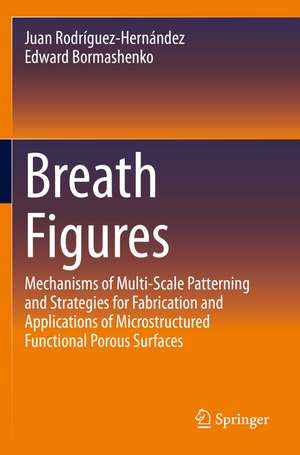Breath Figures: Mechanisms of Multi-scale Patterning and Strategies for Fabrication and Applications of Microstructured Functional Porous Surfaces
Autor Juan Rodríguez-Hernández, Edward Bormashenkoen Limba Engleză Paperback – sep 2021
This book offers a complete and concise overview of the different strategies used to prepare microstructured surfaces employing information regarding surface instabilities and physical processes. Based upon the concept of the remarkably uniform layer of water vapor that is applied when one simply breathes onto a surface in cold temperatures, the book presents a comprehensive treatise addressing chemical and physical fundamentals, fabrication, and applications of the breath figures approach to surface wetting, coating, and modification (breath figures self-assembly) of various materials. The main topics of the book are divided into six parts: the control of surface properties in polymer blends; block copolymer design with the aim of providing order at different lengths; combination of block copolymer blends with the breath figures (BFs); dynamic templating; the breath figures method; biorecognition; and alternative approaches for surface structuring and functionalization.
- Discusses various physical processing methods in preparing microstructured surfaces;
- Describes relevant aspects of micro- and nanostructured surfaces from fabrication to final applications, including additive manufacturing, bacterial adhesion and entrapment, optical and electro-optical applications, and membrane technology;
- Details the breath figures approach to surface structuring while discussing alternative strategies that tie morphology to functionality of materials.
| Toate formatele și edițiile | Preț | Express |
|---|---|---|
| Paperback (1) | 444.08 lei 38-44 zile | |
| Springer International Publishing – sep 2021 | 444.08 lei 38-44 zile | |
| Hardback (1) | 641.71 lei 3-5 săpt. | |
| Springer International Publishing – sep 2020 | 641.71 lei 3-5 săpt. |
Preț: 444.08 lei
Preț vechi: 548.24 lei
-19% Nou
Puncte Express: 666
Preț estimativ în valută:
84.99€ • 88.40$ • 70.16£
84.99€ • 88.40$ • 70.16£
Carte tipărită la comandă
Livrare economică 11-17 aprilie
Preluare comenzi: 021 569.72.76
Specificații
ISBN-13: 9783030511388
ISBN-10: 3030511383
Pagini: 235
Ilustrații: VIII, 235 p. 130 illus., 89 illus. in color.
Dimensiuni: 155 x 235 mm
Ediția:1st ed. 2020
Editura: Springer International Publishing
Colecția Springer
Locul publicării:Cham, Switzerland
ISBN-10: 3030511383
Pagini: 235
Ilustrații: VIII, 235 p. 130 illus., 89 illus. in color.
Dimensiuni: 155 x 235 mm
Ediția:1st ed. 2020
Editura: Springer International Publishing
Colecția Springer
Locul publicării:Cham, Switzerland
Cuprins
Introduction to micropatterned surfaces.- Strategies to fabricate microstructured surfaces.- Breath Figures formation.- Mechanisms.- Parameters involved in BFs.- 3) Methodologies.- Characterization of micro-porous surfaces.- Characterization of ordering observed with micro-porous surfaces.- Voronoi entropy of honeycomb structures.- Wetting of micro-porous surfaces.- Cassie and Wenzel-like wetting regimes.- Honeycomb surfaces as a basis for oil-infused surfaces.- Introducing chemical functionalities to microporous surfaces.- Hierarchically ordered porous surfaces.- From planar surfaces to 3D porous interfaces.- Applications.- Outlook and conclusions.
Notă biografică
Dr. Juan Rodruguez-Fernandez is a professor at the Institute of Polymer Science and Technology of the Consejo Superior de Investigaciones Cientificas, Madrid, Spain. From 2004 through 2008 he served as a researcher at the Laboratoire de Chimie des Polymeres Organiques, Bordeaux, France. He received his Pn.D. from the Max Planck Institute for Polymer Research and conducted postdoctoral studies at the Laboratoire de Chimie des Polymeres Organiques, Bordeaux, France, which was followed by a competitive recruitment at the CNRS. Since 2005, Dr. Juan Rodriguez-Hernandez’s research has been centered around the preparation of surfaces in which both functionality and nanostructure can be controlled. His research group works on controlled functionalization and hierarchical structure of polymer surfaces.
Edward Bormashenko is the Professor of Chemical Engineering and Materials Science of the Ariel University, Israel. He is an author of more than 250 papers and2 monographs. His scientific interest include: surface and polymer science, meta-materials, processes of self-assembly and self-organization, superhydrophobicity, superoleophobicity, creating of surfaces with pre-scribed properties, plasma- and UV-treatment of surfaces, self-propulsion.
Textul de pe ultima copertă
This book offers a complete and concise overview of the different strategies used to prepare microstructured surfaces employing information regarding surface instabilities and physical processes. Based upon the concept of the remarkably uniform layer of water vapor that is applied when one simply breathes onto a surface in cold temperatures, the book presents a comprehensive treatise addressing chemical and physical fundamentals, fabrication, and applications of the breath figures approach to surface wetting, coating, and modification (breath figures self-assembly) of various materials. The main topics of the book are divided into six parts: the control of surface properties in polymer blends; block copolymer design with the aim of providing order at different lengths; combination of block copolymer blends with the breath figures (BFs); dynamic templating; the breath figures method; biorecognition; and alternative approaches for surface structuring and functionalization.
- Discusses various physical processing methods in preparing microstructured surfaces;
- Describes relevant aspects of micro- and nanostructured surfaces from fabrication to final applications, including additive manufacturing, bacterial adhesion and entrapment, optical and electro-optical applications, and membrane technology;
- Details the breath figures approach to surface structuring while discussing alternative strategies that tie morphology to functionality of materials.
Caracteristici
Discusses various physical processing methods in preparing microstructured surfaces Describes relevant aspects of micro- and nanostructured surfaces from fabrication to final applications, including additive manufacturing, bacterial adhesion and entrapment, optical and electro-optical applications, and membrane technology Details the breath figures approach to surface structuring while discussing alternative strategies that tie morphology to functionality of materials
